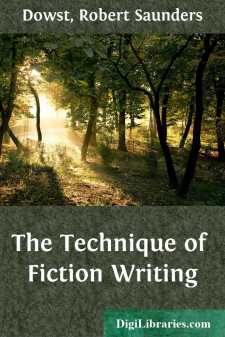Categories
- Antiques & Collectibles 13
- Architecture 36
- Art 48
- Bibles 22
- Biography & Autobiography 813
- Body, Mind & Spirit 142
- Business & Economics 28
- Children's Books 14
- Children's Fiction 11
- Computers 4
- Cooking 94
- Crafts & Hobbies 4
- Drama 346
- Education 46
- Family & Relationships 57
- Fiction 11829
- Games 19
- Gardening 17
- Health & Fitness 34
- History 1377
- House & Home 1
- Humor 147
- Juvenile Fiction 1873
- Juvenile Nonfiction 202
- Language Arts & Disciplines 88
- Law 16
- Literary Collections 686
- Literary Criticism 179
- Mathematics 13
- Medical 41
- Music 40
- Nature 179
- Non-Classifiable 1768
- Performing Arts 7
- Periodicals 1453
- Philosophy 64
- Photography 2
- Poetry 896
- Political Science 203
- Psychology 42
- Reference 154
- Religion 513
- Science 126
- Self-Help 84
- Social Science 81
- Sports & Recreation 34
- Study Aids 3
- Technology & Engineering 59
- Transportation 23
- Travel 463
- True Crime 29
The Technique of Fiction Writing
Description:
Excerpt
INTRODUCTION
"A work of art is first cloudily conceived in the mind; during the period of gestation it stands more clearly forward from these swaddling mists, puts on expressive lineaments, and becomes at length that most faultless, but also, alas! that incommunicable product of the human mind, a perfected design. On the approach to execution all is changed. The artist must now step down, don his working clothes, and become the artisan. He now resolutely commits his airy conception, his delicate Ariel, to the touch of matter; he must decide, almost in a breath, the scale, the style, the spirit, and the particularity of execution of his whole design."
Thus Stevenson, in "A Note on Realism," takes it for granted that the artist in pigments, stone, or words cannot reproduce until he first has produced, cannot show a perfect work unless he paints, builds, or writes along the lines of a perfected design.
One cannot dabble long at architecture or the graphic arts without gaining keen realization of the fact that conception in its elaborative aspects is as much a part and phase of technique as the executive handling of materials. But the art of literature, and, more narrowly, the art of fiction, deal with materials other than those employed in the other arts; words, not colors or marble, nor yet sounds, are the resource of the story teller to precipitate his conception in enduring form; and words are at once frank and mysterious things. Their primary office is to forward the common business of life; each has some meaning in itself, more or less definite. It results that the writer of a story who sets out with only the merest glimmering of what he means to do in mind can produce a superficially plausible work, a work not too obviously misshapen, a work that means something, at any rate, although his failure to trace a design to guide his hand almost inevitably will prohibit his giving the basic conception most effective expression. And, since almost any sequence of words has some significance, it also results that the writer of fiction who works at haphazard may fail to discover that failure in his work as a whole is due to lack of planning rather than to defective execution. The mere grammatical coherence of a fictionally slipshod piece of work is a shield between its writer's inquiring eye and its essential defects.
The art of fiction is the art both of the tale and of the story, fictions that differ radically. Their most striking difference is stated in the following pages; here I can only remark broadly that the tale is episodal, consisting of a fortuitous series of incidents without essential connection or relation except that they all happened to happen to the characters, while the story is a whole in that each incident functions in the development of a plot or dramatic problem. If prevision and full elaboration of his basic idea are essential to the writer of a tale, they are doubly essential to the writer of a story, simply because a story is a whole and the result of careful co-ordination of parts. Even if the writer of some particular story has not worked along the lines of a fully elaborated design, the story actually will manifest co-ordination of parts or else be worthless. A story is more than a series of incidents; it is a series of incidents significant in relation to character. Its writer cannot set to work with an eye solely to the physical spectacle and follow after with his pen; he must prepare his people as well as the events, a task of cunning calculation. He must have an eye to many other matters, but this is not the place to state them. The matter of character is the matter significant here, because the whole difference between tale and story is made by the presence or absence of relation between events and personality. And it is certain that the writer of a story cannot hope to do the best work if he postpones until the moment of actual writing the task of moulding and elaborating his basic idea with a view to giving it maximum effect. The task to express perfectly, in a verbal sense, is difficult enough to claim the undivided attention of the ablest artist, but undivided attention cannot be given the matter of verbal expression by a writer who shapes his substance and picks his words at one and the same time. Either word or substance must suffer.
Accordingly, to emphasize the necessity that the writer of fiction give full shape and development to his design before writing, I have stated the necessity and discussed technique itself under two heads, conceptive or constructive technique and executive technique....


